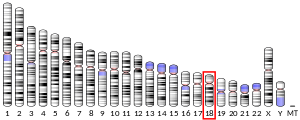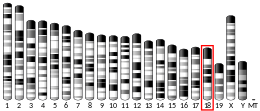GATA6
GATA6GATA-결합인자 6(GATA6)이라고도 하는 전사인자 GATA-6은 인간에서 GATA6 [5]유전자에 의해 암호화되는 단백질이다.유전자 생성물은 우선적으로 결합한다(A/T/C)컨센서스 바인딩 [6]시퀀스의 GAT(A/T)(A)
임상적 의의
유전자의 돌연변이는 췌장아제네시스 및 선천성 [7]심장결함과 관련이 있다.
폐내피발달
아연 손가락 전사인자인 GATA-6는 장기 조직의 [8]내배엽 분화에 중요하다.또한 폐포 상피 및 아쿠아포린-5 프로모터 활성화의 후기 분화 단계를 제어함으로써 적절한 폐 발달에서도 나타난다.또한 GATA-6은 내배엽 배아줄기세포의 증식을 촉진하고 초기 상피세포 분화를 차단하는 사이토카인 LIF의 생산과 관련이 있다.발달하는 배아에서 조절되지 않은 상태로 두면, 이 사이토카인 생산과 화학적 신호는 아래에서 [9]더 자세히 논의되는 표현형에 기여한다.
배아에서 GATA-6이 파괴되면, 말단 폐 상피 발달이 트랜스제닉 마우스[8] 모델에서 저해된다 치조 상피 조직이 발달하고 적절하게 지정되지만, 더 이상의 분화는 일어나지 않는다.또한 말단-근위 기관지 발달에 영향을 미쳐 기도 교환 [8]부위의 양이 감소한다.
출생 후 양쪽 폐저형성증을 일으키는 이 분기결손은 분화된 폐포상피가 없는 영역과 국소적으로 관련되어 있어 이 표현형이 내배엽 기능 고유의 것으로서 간접적으로 부적절한 GATA-6 [10][11]발현과 관련될 수 있다.즉, 기관지 분기 결손은 GATA-6의 직접 전사 오류의 결과가 아니라 그러한 오류의 부작용일 수 있다.
「 」를 참조해 주세요.
레퍼런스
- ^ a b c GRCh38: 앙상블 릴리즈 89: ENSG00000141448 - 앙상블, 2017년 5월
- ^ a b c GRCm38: 앙상블 릴리즈 89: ENSMUSG00000005836 - 앙상블, 2017년 5월
- ^ "Human PubMed Reference:". National Center for Biotechnology Information, U.S. National Library of Medicine.
- ^ "Mouse PubMed Reference:". National Center for Biotechnology Information, U.S. National Library of Medicine.
- ^ "Entrez Gene: GATA6 GATA binding protein 6".
- ^ Sakai Y, Nakagawa R, Sato R, Maeda M (1998). "Selection of DNA binding sites for human transcriptional regulator GATA-6". Biochem Biophys Res Commun. 250 (3): 682–688. doi:10.1006/bbrc.1998.9374. PMID 9784406.
- ^ Chao CS, McKnight KD, Cox KL, Chang AL, Kim SK, Feldman BJ (2015). "Novel GATA6 Mutations in Patients with Pancreatic Agenesis and Congenital Heart Malformations". PLOS ONE. 10 (2): e0118449. Bibcode:2015PLoSO..1018449C. doi:10.1371/journal.pone.0118449. PMC 4338276. PMID 25706805.
- ^ a b c Yang H, Lu MM, Zhang L, Whitsett JA, Morrisey EE (May 2002). "GATA6 regulates differentiation of distal lung epithelium". Development. 129 (9): 2233–46. doi:10.1242/dev.129.9.2233. PMID 11959831.
- ^ Morgani SM, Brickman JM (October 2015). "LIF supports primitive endoderm expansion during pre-implantation development". Development. 142 (20): 3488–99. doi:10.1242/dev.125021. PMID 26395492.
- ^ Keijzer R, van Tuyl M, Meijers C, Post M, Tibboel D, Grosveld F, Koutsourakis M (February 2001). "The transcription factor GATA6 is essential for branching morphogenesis and epithelial cell differentiation during fetal pulmonary development". Development. 128 (4): 503–11. doi:10.1242/dev.128.4.503. PMID 11171334.
- ^ Rennie J (2012). Rennie & Robertson's Textbook on Neonatology. Elsevier Health Sciences. ISBN 978-0-7020-3479-4.
추가 정보
- Maruyama K, Sugano S (1994). "Oligo-capping: a simple method to replace the cap structure of eukaryotic mRNAs with oligoribonucleotides". Gene. 138 (1–2): 171–4. doi:10.1016/0378-1119(94)90802-8. PMID 8125298.
- Suzuki E, Evans T, Lowry J, Truong L, Bell DW, Testa JR, Walsh K (1997). "The human GATA-6 gene: structure, chromosomal location, and regulation of expression by tissue-specific and mitogen-responsive signals". Genomics. 38 (3): 283–90. doi:10.1006/geno.1996.0630. PMID 8975704.
- Huggon IC, Davies A, Gove C, Moscoso G, Moniz C, Foss Y, Farzaneh F, Towner P (1997). "Molecular cloning of human GATA-6 DNA binding protein: high levels of expression in heart and gut". Biochim. Biophys. Acta. 1353 (2): 98–102. doi:10.1016/s0167-4781(97)00049-3. PMID 9294001.
- Yoshida T, Sato R, Mahmood S, Kawasaki S, Futai M, Maeda M (1997). "GATA-6 DNA binding protein expressed in human gastric adenocarcinoma MKN45 cells". FEBS Lett. 414 (2): 333–7. doi:10.1016/S0014-5793(97)01017-X. PMID 9315713. S2CID 31858845.
- Suzuki Y, Yoshitomo-Nakagawa K, Maruyama K, Suyama A, Sugano S (1997). "Construction and characterization of a full length-enriched and a 5'-end-enriched cDNA library". Gene. 200 (1–2): 149–56. doi:10.1016/S0378-1119(97)00411-3. PMID 9373149.
- Wada H, Hasegawa K, Morimoto T, Kakita T, Yanazume T, Sasayama S (2000). "A p300 protein as a coactivator of GATA-6 in the transcription of the smooth muscle-myosin heavy chain gene". J. Biol. Chem. 275 (33): 25330–5. doi:10.1074/jbc.M000828200. PMID 10851229.
- Crawford SE, Qi C, Misra P, Stellmach V, Rao MS, Engel JD, Zhu Y, Reddy JK (2002). "Defects of the heart, eye, and megakaryocytes in peroxisome proliferator activator receptor-binding protein (PBP) null embryos implicate GATA family of transcription factors". J. Biol. Chem. 277 (5): 3585–92. doi:10.1074/jbc.M107995200. PMID 11724781.
- Liu C, Glasser SW, Wan H, Whitsett JA (2002). "GATA-6 and thyroid transcription factor-1 directly interact and regulate surfactant protein-C gene expression". J. Biol. Chem. 277 (6): 4519–25. doi:10.1074/jbc.M107585200. PMID 11733512.
- Kiiveri S, Liu J, Westerholm-Ormio M, Narita N, Wilson DB, Voutilainen R, Heikinheimo M (2003). "Transcription factors GATA-4 and GATA-6 during mouse and human adrenocortical development". Endocr. Res. 28 (4): 647–50. doi:10.1081/ERC-120016980. PMID 12530677. S2CID 22011163.
- Chang DF, Belaguli NS, Iyer D, Roberts WB, Wu SP, Dong XR, Marx JG, Moore MS, Beckerle MC, Majesky MW, Schwartz RJ (2003). "Cysteine-rich LIM-only proteins CRP1 and CRP2 are potent smooth muscle differentiation cofactors". Dev. Cell. 4 (1): 107–18. doi:10.1016/S1534-5807(02)00396-9. PMID 12530967.
- Nemer G, Nemer M (2003). "Transcriptional activation of BMP-4 and regulation of mammalian organogenesis by GATA-4 and -6". Dev. Biol. 254 (1): 131–48. doi:10.1016/S0012-1606(02)00026-X. PMID 12606287.
- Abe M, Hasegawa K, Wada H, Morimoto T, Yanazume T, Kawamura T, Hirai M, Furukawa Y, Kita T (2003). "GATA-6 is involved in PPARgamma-mediated activation of differentiated phenotype in human vascular smooth muscle cells". Arterioscler. Thromb. Vasc. Biol. 23 (3): 404–10. doi:10.1161/01.ATV.0000059405.51042.A0. PMID 12615657.
- Ketola I, Toppari J, Vaskivuo T, Herva R, Tapanainen JS, Heikinheimo M (2003). "Transcription factor GATA-6, cell proliferation, apoptosis, and apoptosis-related proteins Bcl-2 and Bax in human fetal testis". J. Clin. Endocrinol. Metab. 88 (4): 1858–65. doi:10.1210/jc.2002-021647. PMID 12679484.
- Siltanen S, Heikkilä P, Bielinska M, Wilson DB, Heikinheimo M (2004). "Transcription factor GATA-6 is expressed in malignant endoderm of pediatric yolk sac tumors and in teratomas". Pediatr. Res. 54 (4): 542–6. doi:10.1203/01.PDR.0000081295.56529.E9. PMID 12867597.
- Liu C, Ikegami M, Stahlman MT, Dey CR, Whitsett JA (2003). "Inhibition of alveolarization and altered pulmonary mechanics in mice expressing GATA-6". Am. J. Physiol. Lung Cell Mol. Physiol. 285 (6): L1246–54. doi:10.1152/ajplung.00443.2002. PMID 12909592.
- Benchabane H, Wrana JL (2003). "GATA- and Smad1-Dependent Enhancers in the Smad7 Gene Differentially Interpret Bone Morphogenetic Protein Concentrations". Mol. Cell. Biol. 23 (18): 6646–61. doi:10.1128/MCB.23.18.6646-6661.2003. PMC 193708. PMID 12944489.
- Jimenez P, Saner K, Mayhew B, Rainey WE (2003). "GATA-6 is expressed in the human adrenal and regulates transcription of genes required for adrenal androgen biosynthesis". Endocrinology. 144 (10): 4285–8. doi:10.1210/en.2003-0472. PMID 12959982.
- Saner KJ, Suzuki T, Sasano H, Pizzey J, Ho C, Strauss JF, Carr BR, Rainey WE (2005). "Steroid sulfotransferase 2A1 gene transcription is regulated by steroidogenic factor 1 and GATA-6 in the human adrenal". Mol. Endocrinol. 19 (1): 184–97. doi:10.1210/me.2003-0332. PMID 15388788.
- Kiiveri S, Liu J, Heikkilä P, Arola J, Lehtonen E, Voutilainen R, Heikinheimo M (2005). "Transcription factors GATA-4 and GATA-6 in human adrenocortical tumors". Endocr. Res. 30 (4): 919–23. doi:10.1081/ERC-200044149. PMID 15666845. S2CID 27526305.
외부 링크
- GATA6+단백질+미국 국립의학도서관의 의학 주제 제목(MeSH)






